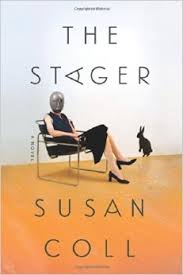The Stager: A Novel
- By Susan Coll
- Sarah Crichton Books
- 288 pp.
- Reviewed by Dana Norris
- August 27, 2014
This comedy set in the Washington, DC, suburbs focuses on a family victim to a stale real estate market.

They need to sell their insufferably large home so they may move to London in order for matriarch Bella’s career to take off in full. But their house isn’t selling.
There are several possible reasons for the lack of interested buyers: the home is an increasingly out-of-fashion McMansion; the experimental high-end commune across the street failed; the family’s pet rabbit, Dominique, is continually wreaking havoc on the carpet; and the place has a deeply offensive smell emanating from…somewhere.
The fact that they own such a large home in the first place is a result of Lars, the husband’s, ability “to be able to move from thing to thing and continue to find new pleasure, over and over and over, in the unwrapping of cellophane, or the snipping off of price tags.” He sees his knack for always finding joy in consumerism to be a gift, one that makes life worth living, and one he is loath to give up. Lars used to be a handsome tennis pro, but today he is a debilitated pill addict who requires a specific amount of natural light in order to function.
There are very good reasons why no one should buy this house, but the real estate’s agent solution is to hire a home stager. Eve, the stager, is discovered by the realtor just as she is “unemployed, not quite divorced, in the same clothes I’d slept in, defrosting hot dog buns to use as toast in an effort to avoid having to get properly dressed to go to the grocery store.”
But as dismal as Eve’s life may be, her ability to stage a home and make it more palatable to potential buyers is uncanny. She is given one week in which to ply her trade while Bella and Lars are in London searching for a new home, and Elsa, their 10-year-old daughter, is under a nanny’s care. Elsa instantly recognizes Eve as the most stable adult figure to enter her life in years, though Eve resists a relationship with the girl. Her reasons for doing so become clear only as the plot advances and the characters’ artifices begin to crack.
The book is written from four points of view: Lars, Elsa, Eve, and a surprise member of the family whose identity I won’t spoil here. Bella does not narrate, but she is the unspoken center of this book, and all the action swirls around her mysterious self. Why does she do the things that she does? Why can’t those who love her satisfy her need for perfection? Why are all of these characters in her thrall?
While Eve spruces up the home, everything begins to go wrong — from a runaway rabbit, to red paint on a white carpet, to psychedelic tea, to the incorrect installation of a skylight, to the conundrum of what, exactly, American Girl dolls should eat.
There are deeply funny moments in the novel, including medication combinations that cause literary side effects. I came away from this book with an appreciation for home staging, the mythic importance of rabbits, and the joy of listening to some very funny characters while they are in the midst of an uncontrollable downward spiral.
Still, there are instances of back-and-forth between characters that seem to swing around one too many times, and I was aching at the end of the book to hear anything from Bella’s point of view. The Stager aims to comment on consumerism, the need to acquire, and the need for perfection. Why stage your home? Why present your best face to the world? Why pretend to succeed even while failure seeps out of your every pore? These are fascinating questions, though I’m not sure this book means to answer them.
In the end, it appears that the McMansion has prevailed — because luckily, says Eve, “There are few problems in either home staging or personal appearance that can’t be solved, or at least improved, by adjusting the light.” Even if those items now cast in shadow are, in fact, still there.
[Susan Coll will appear at this year’s Fall for the Book festival, which takes place Sept. 11-18 at locations around the DC metro area.]
Dana Norris is the editor-in-chief of Story Club Magazine and the founder of the Story Club franchise. She teaches at StoryStudio Chicago and has been published in McSweeney’s Internet Tendency, the Rumpus, the Tampa Review, and other places.
